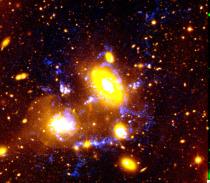TNG images unveil giant filament structures in a galaxy cluster
An international team of astronomers has used DOLORES-TNG to study the physical properties of a compact group of starburst galaxies which is falling at a speed of 1700 km/s towards the centre the galaxy cluster Abell 1367. The group, which was discovered in 2002 and named "BIG", has the highest density of star forming objects ever observed in local clusters. It contains two giant galaxies, at least ten dwarf galaxies or extragalactic clouds of gas and over a billion solar masses of diffuse gas filaments.
The giant gaseous trails, revealed by the narrow band image centered on the Halpha line produced by ionized hydrogen gas (Fig. 1), mark the path of galaxies travelling at high speed through the cluster. The origin of these unique features is probably the result of the combined action of tidal forces among galaxies in the cluster and of ram-pressure by the ambient medium which caused the galaxies to fragment and blast out the ionized gas.
The results of this study have been advertised by the Royal Astronomical Society and published on Astronomy and Astrophysics. More details can be found in the web page http://goldmine.mib.infn.it/papers/preprocessing.html.
Fig. 1 False-colour image of the BIG group of starburst galaxy. Blue is the Halpha continuum-subtracted image, Red is the r' broad-band filter and Green is the total flux in the narrow band filter.
Cortese L. et. al., "Witnessing galaxy preprocessing in the local Universe: the case of a star-bursting group falling into Abell 1367", 2006, A&A, 453, 847)


